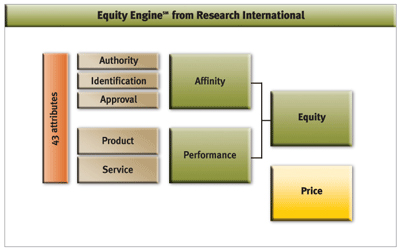Why CMOs Need Common Metrics to Survive: It’s Time To Make GAAP for Marketers
NASCAR drivers should watch out: the position of Chief Marketing Officer is fast replacing race-car driver as the riskiest job in North America.
According to Business Week, a CMO’s average tenure is only 28 months. Only 14 percent of CMOs for the worlds top brands have been in their jobs more than three years.
 That’s dramatically different from their C-level peers:
That’s dramatically different from their C-level peers:
- CEOs overall have an average tenure of 95 months (ITBusiness Edge)
- Fortune 1000 CEOs on average last 73 months. (Forbes.com)
- CFO average tenure is 52 months (CFO.com)
- CIO Tenure is 76 months. (ITBusiness Edge)
Change in Marketing Isn’t Always Good
High leadership turnover disrupts innovation and breeds chaos. New leaders often turn to their firm’s creative efforts to show fast, tangible change. This almost always distracts from thornier interdepartmental issues, which is where market strategy meets the firm. This muddies the firm’s identity in the marketplace, and internally makes the new CMO seem fixated on advertising or MarCom rather than strategy and revenue growth.
There’s also a temptation for CMOs to bring in their own team, which can tank productivity while the new arrivals figure out the business and the remaining crop of young marketers politically showcase their worthiness. Introducing a “hired gun” CMO raises fair questions about the career path for the company’s emerging marketing talent, many of whom will take the lesson that the path to promotion is an external one.
Marketing’s horse power has increased, it now has mechanisms to deliver 1:1 personalized mass marketing, using optimization, social CRM, and elaborate analytics. It is gaining a crew of experts in these disciplines, and more than ever CEO’s look to marketing to lead revenue growth. It no time for marketing’s leadership to be driving under a yellow flag.
Here are my thoughts on what we need to change in marketing — and by “we” I mean all of us: everyone in business.
Truth #1: Nobody Knows What the Hell Marketing is Doing
Why do Chief Marketers last one-third the time of their executive peers? The short answer: nobody knows what marketing is doing, and it’s easy for outsiders to imagine they can run the “make-it-pretty department” better. That’s what phrases like “misaligned performance expectations” boil down to.
Fact #2: Marketing Needs to Get Its Professional House in Order
In a recent Harvard Business Review article, Richard Barker described a profession as a “generally accepted and relatively permanent knowledge asymmetry.” It’s when people recognize that practitioners of a discipline generally know more about a certain topic than than they do, and so trust their advice.
The body of knowledge required of physicians, lawyers, and even project managers is highly codified. In my current department, my first priority was setting a base of analytics and design doctrine so my digital managers could have a shared approach to the basics of our work.
Ask 40 marketers what a brand is: you’ll get 40 often very different answers. Until we have a common language and consistency, it’s no wonder that marketing seems to be “everywhere and nowhere at once.”
Fact #3: Uniform Reporting Drives Accountability, Credibility, and Visibility
Why is it that the collaboration of Marketing and Finance so often starts at the most rudimentary level? The CEO has the general structure of a balance sheet whose key metrics are used to compare the financial performance of companies across industries. Profit and Loss Statements are standardized via Generally Accepted Accounting Principles (GAAP), trued through an audit, and used as reliable corporate measures from Kansas to Kuala Lumpur.
But the Association of National Advertisers’ Marketing Accountability Conference found that most financial executives don’t accept Marketing’s forecasts or ROI calculations.
- Nine out of 10 said they don’t use ROI metrics to set marketing budgets in the annual budgeting cycle.
- Seven out of 10 said their companies don’t use marketing inputs and forecasts in financial guidance to Wall Street or public disclosures.
- Four out of 10 said marketing forecasts made inside their company can’t pass the muster of a standard corporate audit.
CFOs and CMOs need to work together to build a shared business model, grounded in a set of key performance metrics that connect it to revenue and value creation.
Fact #4: GAAP Should Recognize Corporate Fortunes Are Tied to Brand Equity

The accounting profession’s conventions have been slow to recognize the growth of brand value as a corporate asset. Perhaps more than any other factor, this blind spot allows marketing to remain a dark art.
GAAP standards don’t account for the value of brands until a company is bought or sold. This creates a disconnect between marketing and the rest of the firm that orients its actions to the corporate balance sheet. I believe the creation of consistent and reliable standards for marketing measurement is the single most important business issue of this decade.
Jonathan Knowles and Wolff Olins blogged for Emory Universities Brand Institute:
To qualify as an “asset” in financial terms, a brand needs to be measured in terms of its ability to generate future cash flow… Changes in customer attitudes are nice, but in and of themselves they do not generate cash flow.
Their post goes on to recount a half-dozen models for estimating brand health and value. Fifteen years ago, the doctoral students teaching my finance classes were working on ways to get brand equity on the books.
While there’s plenty marketers can do to standardize their practices and work across departments, assigning a book value to the health of brands will both give a better view of corporate value to owners — and bring one of marketing’s primary fixations on to the corporate ledger.

 The future of digital experiences will be built by strategists who grasp the full array of emerging business, social, and technical models. Specialties in user experience, branding, application design, and data science are laying the foundation for richer user experiences and business models breakthrough products and revenue based marketing.
The future of digital experiences will be built by strategists who grasp the full array of emerging business, social, and technical models. Specialties in user experience, branding, application design, and data science are laying the foundation for richer user experiences and business models breakthrough products and revenue based marketing.
6 Responses to "Why CMOs Need Common Metrics to Survive: It’s Time To Make GAAP for Marketers"
August 3, 2010
As CMO at a public company, there were only two times the CFO cared about what I’ve had to say:
1. When he was looking for Brand Impairment or Customer LTV changes, in order to lower our required final payout on an acquisition.
2. When he and the HR dept rationalized headcount RIF plans.
Routine metrics, including sales pipeline metrics & contributions, projected revenue & traffic counts, ROI on campaigns — all ignored because they aren’t GAAP compliant standards.
Been there, done that. It sucks.
August 3, 2010
Inneresting post, Dave. Thanks.
I’m wondering if part of the problem is disparate nature of the activities that fall under the “marketing” rubric since these activities can have very different measurable outcomes.
For example, at CPG companies, product managers generally “own” the P&L for a product. Measuring that person’s effectiveness in terms of dollars (how much did you spend and how much came in) seems fairly straightforward.
Now look at the PR function at a CPG company. Measuring the effectiveness of that person’s activities in terms of “mentions” or something like that might be easy, but translating “mentions” into dollars might not.
Now, if the CMO oversees product management, on the one hand, and PR on the other, how is his or here performance going to be measured? Add investor relations, advertising, corporate communications, etc. into the mix and the picture gets cloudier.
At smaller companies, of course, you don’t have a CMO and the CEO effectively oversees all these activities. Does the CMO role suffer due to the overlap with the CEO function (without the executive power)?
August 3, 2010
Matthew T. Grant illustrated a natural dynamic, the CMO and CEO are both brand stewards. But the CEO has the higher calling of being the Balance Sheet’s steward too.
No where is this more clear than the apparel industry. Brand is a huge source of value. Average CMO tenure: 10 months.
Average CEO tenure: over 200 months.
This is a big disconnect, and a threat to business.
The first post ending in “been there, done that, it sucks” hits it head on. If its not on GAAP, it is largely not real to the business.
Until GAAP allows recognition of brand stewardship, there is a fault line between these roles. And CMO’s trust and hope the rest of the firm will join them in building something that may take years to accrue book value.
Thanks to everyone who has Tweeted and sent encouragement on this post. I appreciate the thoughts.
August 11, 2010
[…] have a hard time connecting the dots for our colleagues in the rest of the enterprise, according to a recent post by David Wieneke on the UsefulArts.us blog: [T]he Association of National Advertisers’ Marketing Accountability Conference found that most […]
May 1, 2012
Hey Professor Wieneke,
Love the use of the term “Brand Stewardship.” I just did a case study on the former Ogilvy & Mather CEO, Charlotte Beers, and that was a concept that she introduced to the agency back in the 90’s.
Todd
May 4, 2012
Thank you, sir. Its a great concept — I took a finance class from a guy who specialized in valuing brand equity.
Until something is on the balance sheet, its hard to convince a company that it exists.
If you like, and I’d be glad to hear what you learned about Ogilvy.
Best,
Dave